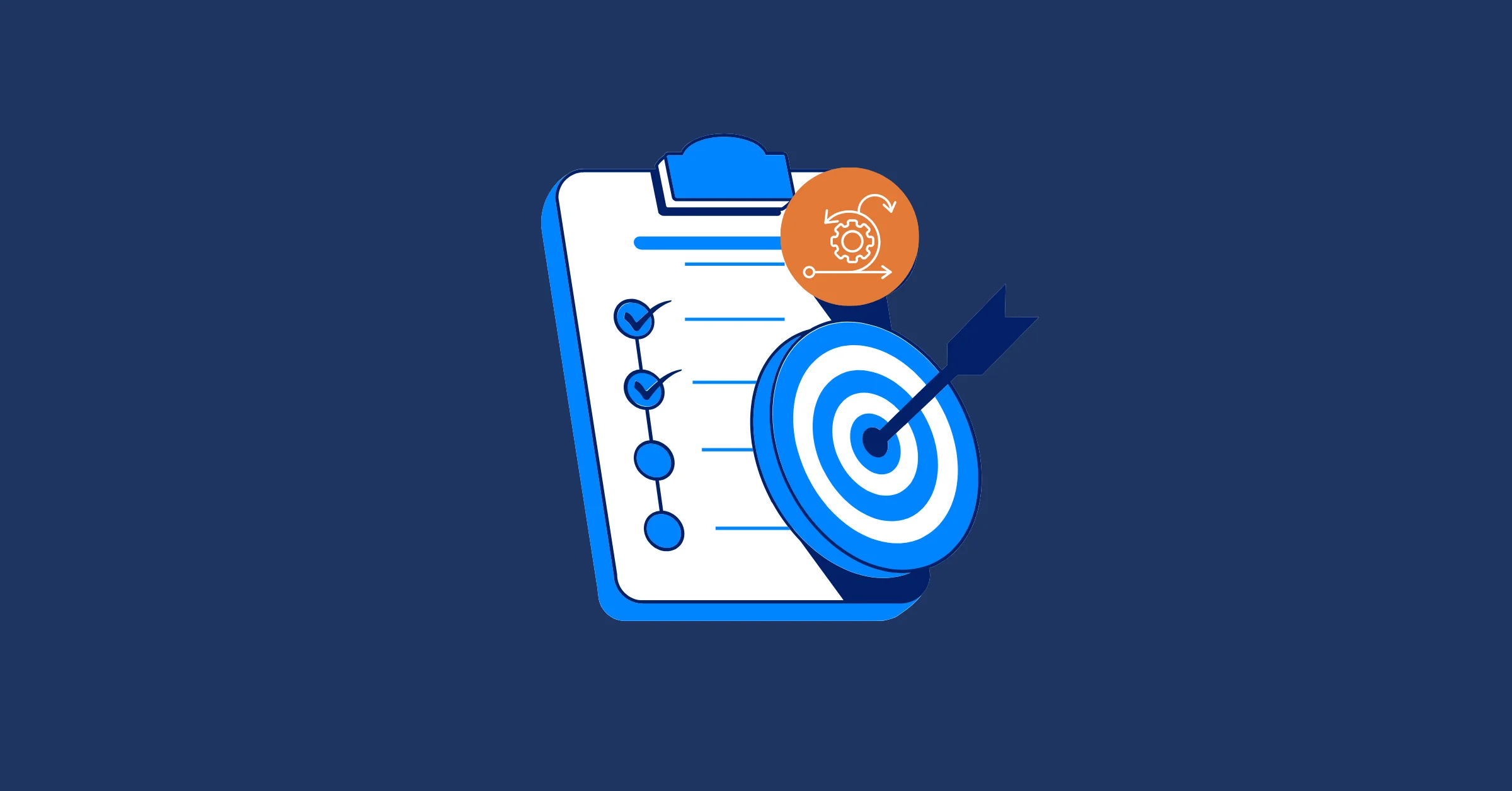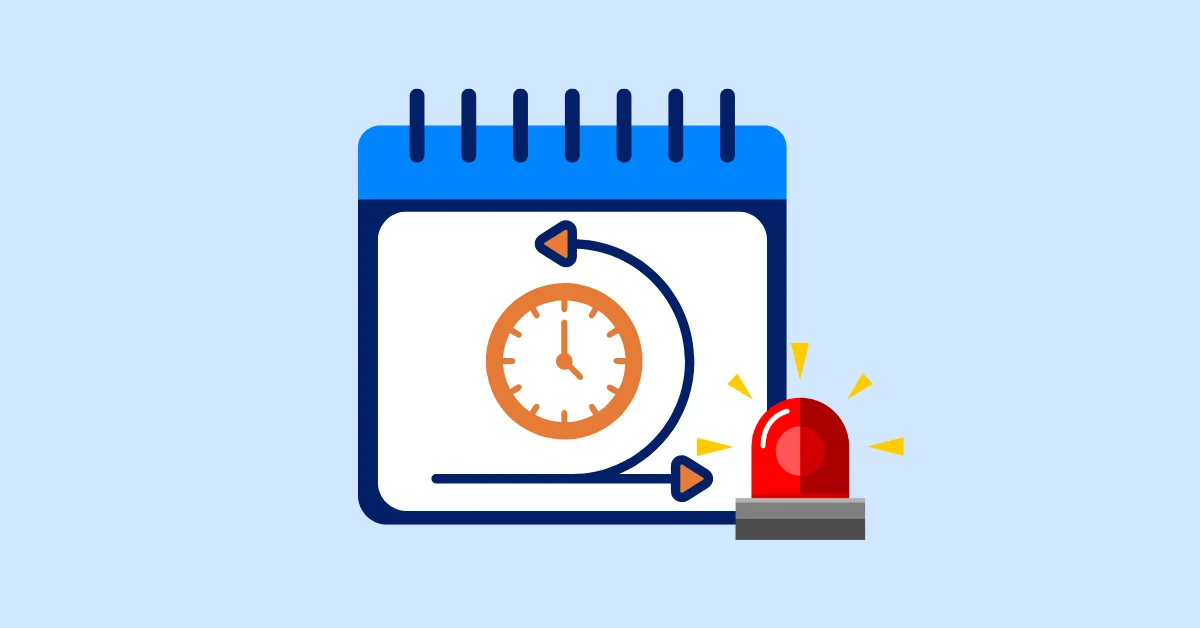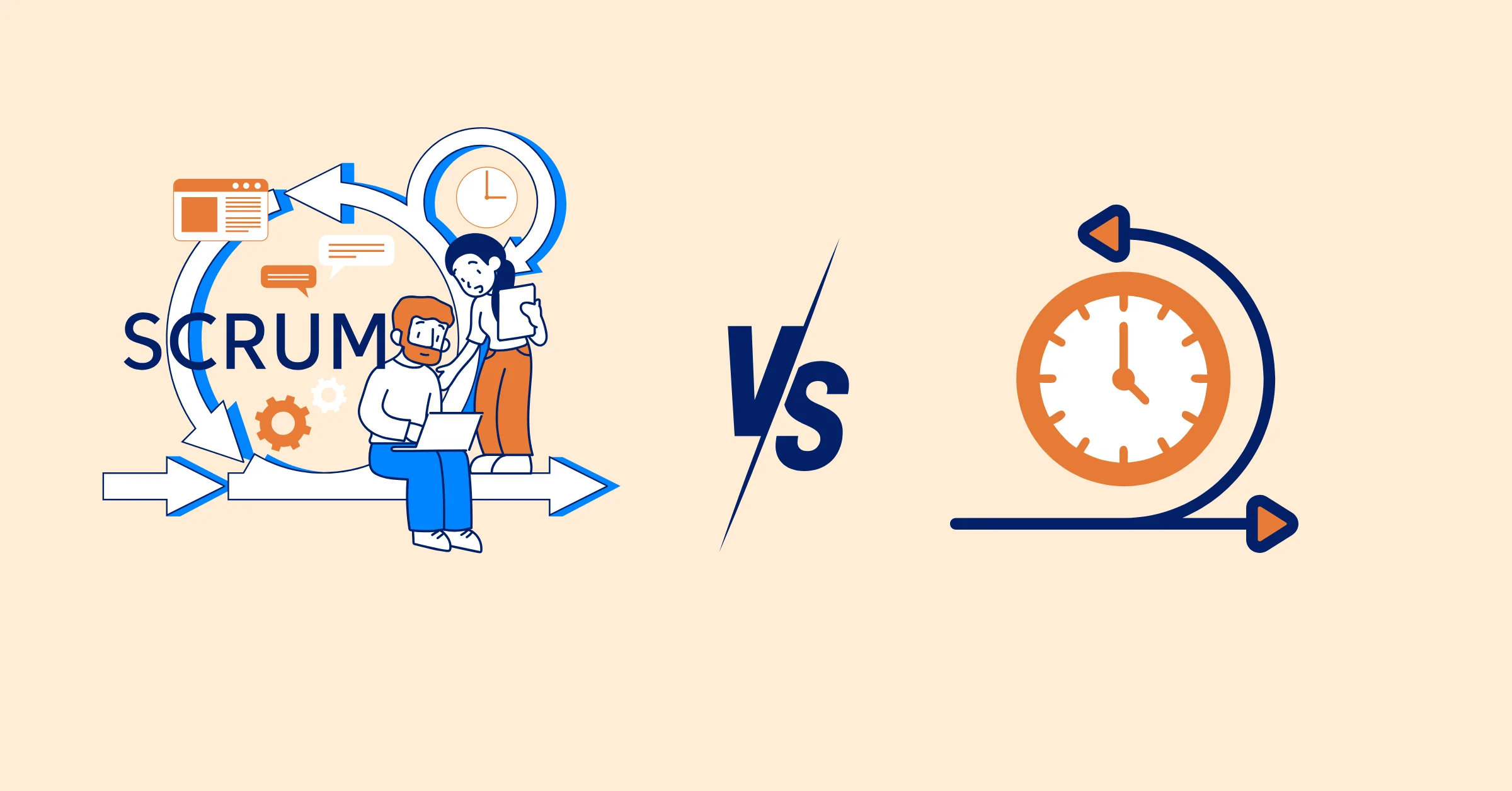How to Make a Project Development Plan that Minimizes Risks (Free Template)
Learn how to create a project development plan that minimizes risks with our step-by-step guide and free template. Perfect for project managers seeking effective strategies.
Creating a project development plan that minimizes risks is a critical skill for project managers aiming to deliver successful outcomes. A well-crafted plan serves as a roadmap, guiding teams through complex projects while anticipating and addressing potential challenges. This article provides a step-by-step guide to building a robust project development plan, with practical strategies to reduce risks and a free, downloadable template to streamline your process. Whether you're managing a small team or an enterprise-level initiative, these insights will help you plan effectively and keep risks in check.
What is a Project Development Plan?

A project development plan is a comprehensive document that outlines the processes, tasks, resources, timelines, and objectives for completing a project. It serves as a roadmap, guiding the team through each phase while ensuring that the project stays on track. In addition to providing clarity, a project development plan includes risk management strategies that are essential for identifying, assessing, and mitigating potential risks throughout the project lifecycle.
A strong project development plan enables project managers to foresee problems, allocate resources efficiently, and make adjustments proactively, all of which are key to minimizing risks.
Key Benefits of a Risk-Focused Plan
- Clarity: Defines goals and expectations, reducing misunderstandings.
- Risk Reduction: Identifies potential issues early and provides mitigation strategies.
- Efficiency: Streamlines resource allocation and task prioritization.
- Stakeholder Confidence: Builds trust through proactive planning and transparency.
Why Minimizing Risks in Project Development is Crucial
Minimizing risks in project development is not only about avoiding negative outcomes but also about ensuring project success. Risks, if left unchecked, can cause:
- Project delays: These can lead to missed deadlines, which may affect stakeholder trust.
- Increased costs: Unmanaged risks often result in budget overruns, damaging the financial health of the project.
- Stakeholder dissatisfaction: Risks that aren’t addressed early can result in poor outcomes and a lack of trust from clients and team members.
- Resource mismanagement: Poor planning can lead to wasted resources, which could have been allocated more effectively.
Effective **risk management **in your project development plan allows you to tackle challenges before they escalate, ensuring smoother project execution.
Learn more: Enterprise Risk Management (ERM): What It Means and How It Works
Step-by-Step Guide to Creating a Project Development Plan
Below is a detailed process for crafting a project development plan that prioritizes risk management. Each step includes practical tips to ensure your plan is actionable and effective.
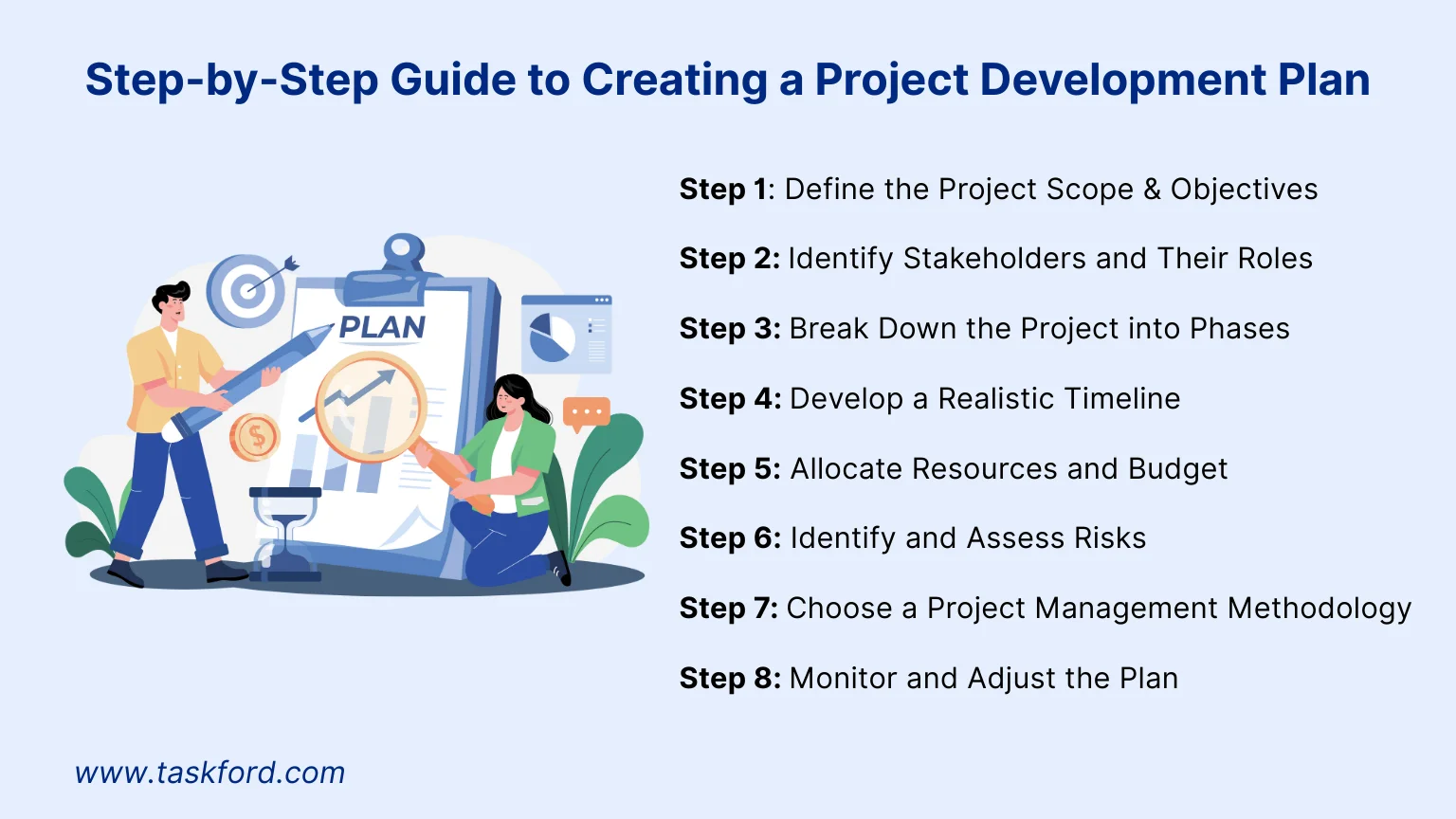
Step 1: Define the Project Scope and Objectives
The foundation of any project development plan is a clear scope. Without it, projects can spiral into scope creep, where unplanned tasks inflate costs and timelines. Start by answering:
- What is the project’s primary goal?
- What deliverables are expected?
- What are the boundaries (what’s included and excluded)?
Risk Mitigation Tip: Engage stakeholders early to confirm objectives. Misaligned expectations can derail projects. Document assumptions (e.g., resource availability) and validate them with key players to avoid surprises.
Example: For a software development project, specify whether the deliverable is a prototype or a fully functional app. Use a scope statement like, “Develop a web-based CRM system with user authentication and reporting features, excluding mobile app development.”
Step 2: Identify Stakeholders and Their Roles
List all stakeholders - sponsors, team members, clients, and end-users - and define their responsibilities. Clear roles prevent confusion and ensure accountability.
- Risk Mitigation Tip: Create a RACI matrix (Responsible, Accountable, Consulted, Informed) to clarify who does what. Miscommunication among stakeholders can lead to delays or conflicting priorities.
- Example: For a construction project, the project manager is accountable for the timeline, while the architect is responsible for design approvals. Share the RACI matrix with all stakeholders to align expectations.
Step 3: Break Down the Project into Phases
Divide the project into manageable phases, such as initiation, planning, execution, monitoring, and closure. This aligns with standard project planning practices and makes complex projects easier to track.
- Risk Mitigation Tip: Use a Work Breakdown Structure (WBS) to detail tasks within each phase. A WBS reduces the risk of overlooking critical activities. For example, in a marketing campaign, break down “content creation” into subtasks like “draft blog posts,” “design graphics,” and “schedule social media.”
Step 4: Develop a Realistic Timeline
Create a timeline with milestones and deadlines for each phase. Use tools like Gantt Charts to visualize task dependencies and durations.
- Risk Mitigation Tip: Build in buffer time (e.g., 10-15% of the total timeline) to account for unexpected delays, such as supplier issues or team member absences. Avoid overly optimistic schedules, which can lead to burnout or missed deadlines.
- Example: For a six-month project, allocate five months for core tasks and one month for contingencies. If a milestone is delayed, adjust dependent tasks proactively to stay on track.
Step 5: Allocate Resources and Budget
Identify the people, tools, and funds required for the project. Be specific about team skills, equipment needs, and financial limits.
- Risk Mitigation Tip: Conduct a resource gap analysis to identify shortages early. For instance, if your team lacks a data analyst, plan to hire or train someone before the project starts. Overbudgeting slightly (e.g., 5-10%) can also cover unexpected costs.
- Example: For an event planning project, list resources like venue costs, catering, and marketing materials. Confirm vendor availability to avoid last-minute scrambles.
Step 6: Identify and Assess Risks
Risk identification is the cornerstone of a risk-minimized project development plan. Brainstorm potential risks, such as technical failures, resource shortages, or external factors like regulatory changes.
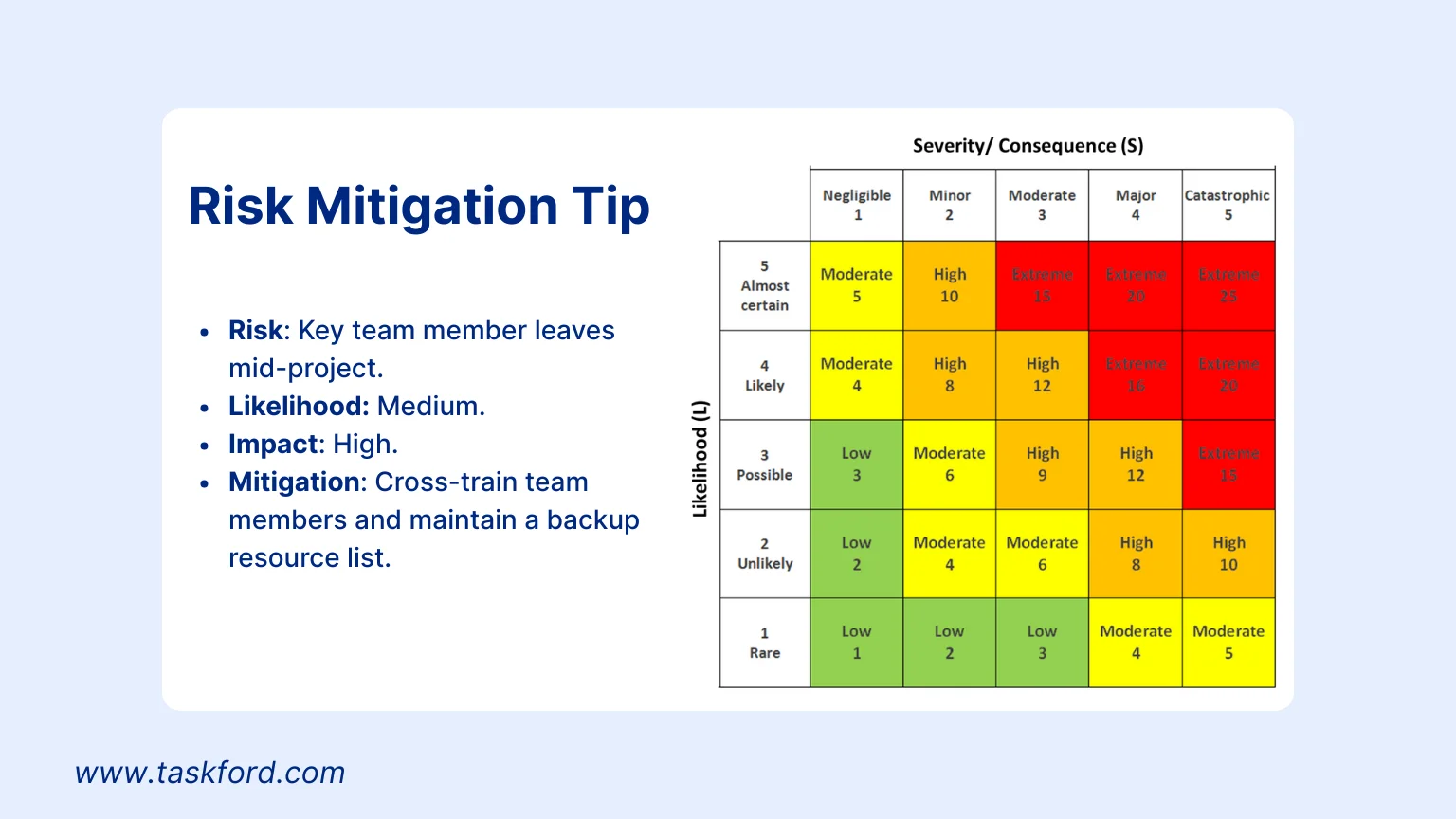
Risk Mitigation Tip: Use a risk register to document each risk, its likelihood, impact, and mitigation strategy. Categorize risks as high, medium, or low priority. For example:
- Risk: Key team member leaves mid-project.
- Likelihood: Medium.
- Impact: High.
- Mitigation: Cross-train team members and maintain a backup resource list.
Regularly update the risk register as the project progresses to address new challenges.
Step 7: Choose a Project Management Methodology
Select a methodology that suits your project’s needs, such as Waterfall for linear projects or Agile for iterative ones. This choice shapes how you manage tasks and risks.
- Risk Mitigation Tip: Match the methodology to the project’s complexity. For example, Agile’s sprints allow frequent reassessment of risks in dynamic projects, while Waterfall’s structured approach suits projects with fixed requirements.
- Example: A software project might use Agile to adapt to changing client needs, while a construction project might use Waterfall for its predictable phases.
Check out our guide on What is Project Management to choose the best Project Management Methodology that suits your team.
Step 8: Monitor and Adjust the Plan
A project development plan isn’t static. Regular monitoring ensures you catch deviations early. Use key performance indicators (KPIs) like budget variance or milestone completion rates to track progress.
Risk Mitigation Tip: Schedule weekly check-ins with your team and stakeholders to review progress and risks. Use project management software like Taskford to automate updates and flag issues.
Example: If a deliverable is behind schedule, reallocate resources or adjust the timeline before it impacts the critical path.
Free Template for Download for a Project Development Plan
To help you apply these steps, we’ve created a free, customizable project development plan template. It includes sections for scope, stakeholders, timeline, resources, risk register, and more. Download it to jumpstart your planning and minimize risks from day one.
Download ResourceHow to Use Your Plan to Drive Success
A project development plan is only as good as its execution. Share the plan with all stakeholders, ensure buy-in, and use it as a living document. Regularly review and update it to reflect new risks or changes. By prioritizing risk minimization, you’ll not only meet project goals but also build a reputation for reliability.
For more insights on effective planning, check out our guide on project planning.
Conclusion
A project development plan that minimizes risks is a powerful tool for delivering successful projects. By following the steps outlined—defining scope, identifying stakeholders, breaking down tasks, and proactively managing risks—you can create a plan that keeps your project on track. Download our free template from TaskFord to get started, and use these strategies to navigate challenges with confidence. With careful planning and a focus on risk management, you’ll set your team up for success.
Making work simpler,
smarter, and more connected
Join our waitlist and be notified first.

Related Blog
Subscribe for Expert Tips
Unlock expert insights and stay ahead with TaskFord. Sign up now to receive valuable tips, strategies, and updates directly in your inbox.


